Many foreign visitors who choose to visit Iran also schedule a time to explore the tourist sites in Shiraz. For a number of reasons, the city is well-known around the world, and many people have heard of it.
Shiraz, a historic city, is known as the “City of Love and Literature,” and the creation of the first Persian gardens is a special illustration of the friendliness and love of its inhabitants.
Shiraz has several attractions nowadays, including historical structures and monuments. There are lots of things to do in Shiraz. It is thought that the city has existed for more than 4,000 years. The city has a lengthy history, which accounts for the significance of Shiraz’s historical places among the historical cities of the globe.
Consider checking out this informative article which highlights 25 of Iran historical sites worth exploring.
So without further ado, here are the top 13 historical places to see in Shiraz.
1-Nasir al-Mulk Mosque
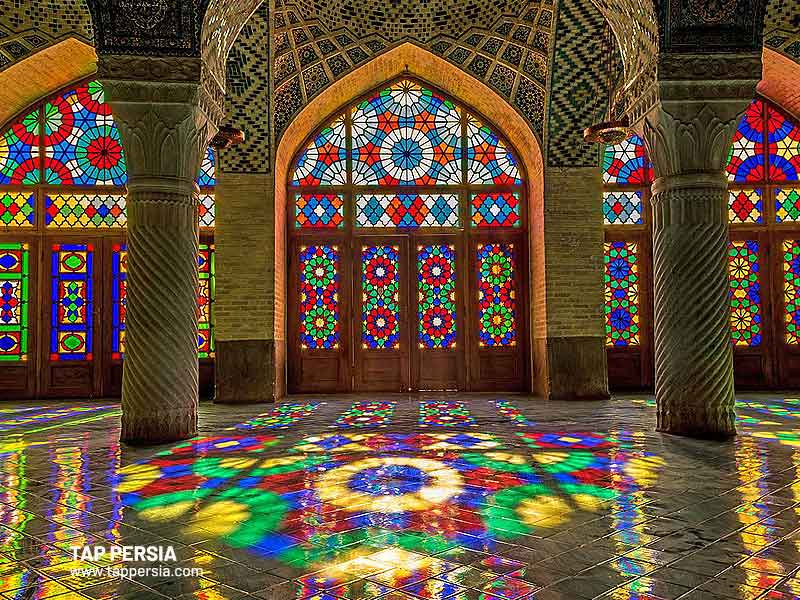
The Nasir al-Mulk Mosque is one of the best Shiraz historical places. This house of worship is a stunning rainbow of color in every direction, like entering into a kaleidoscope, thanks to the brilliant stained glass, the hundreds of painted tiles on the ceiling, and the Persian rugs covering the floor.
A flower-filled open courtyard with a rectangular pool in the middle may be seen inside the mosque. Numerous arabesque arches decorate the building’s exterior, which enhances the elegance of the stained-glass light display.
Between 1876 and 1888, the Qajar dynasty, which governed Iran from 1785 until 1925, built the Nasir al-Mulk Mosque. Due to the abundance of pink tiles covering the ceiling, it has been called the “Pink Mosque.” Early in the morning is the ideal time to visit the mosque since the sun reflects the floor’s stained-glass designs.
2-Tomb of Hafez
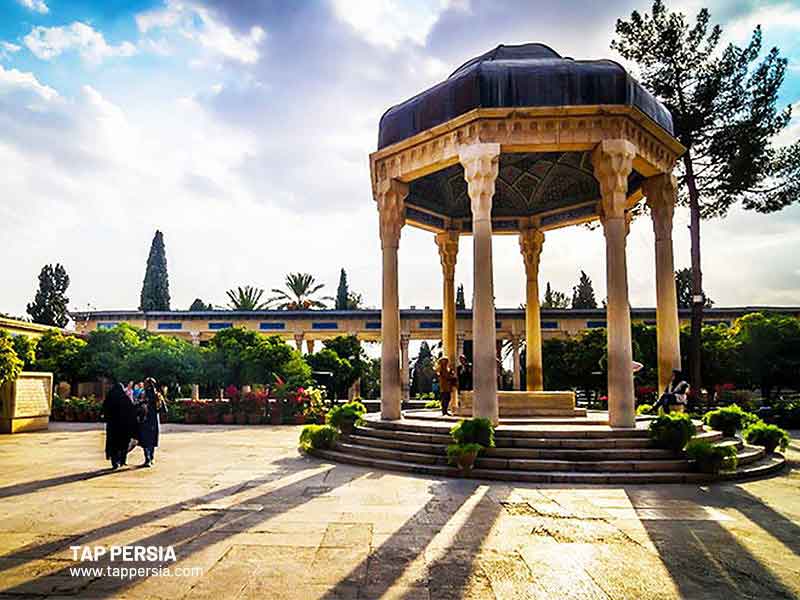
Hafez, often referred to as Khajeh Shams al-Din Mohammad Shirazi, was a well-known author of Persian poetry. In the year 726 Hijri, he was born in Shiraz. He learned about science and technology and received high scores in that era’s literature in the teachers’ classrooms of his day.
He spent a lot of time thinking theologically and memorized the Quran using fourteen distinct narrations. He was highly influenced by the ideals of the renowned German philosopher, poet, and orator “Goethe,” who founded his Eastern Court in his honor.
His poetry works include session poems, a variety of odes and Masnavis, sonnets, and rubaiyat. At the year 192 Hijri, he passed away in Shiraz. His tomb in Shiraz is a revered location among scholars and admirers of Persian literature and poetry and is also considered one of the best Shiraz historical places.
A group of tombs known as Hafezieh (Hafez Tomb) is located south of Qur’an Gate and north of Shiraz. The compound is known by this name since it contains Hafez Shirazi’s tomb. The Tomb of Hafez was constructed during the Zandi dynasty, and its current design dates from its renovation in 1315.
3-Eram Garden
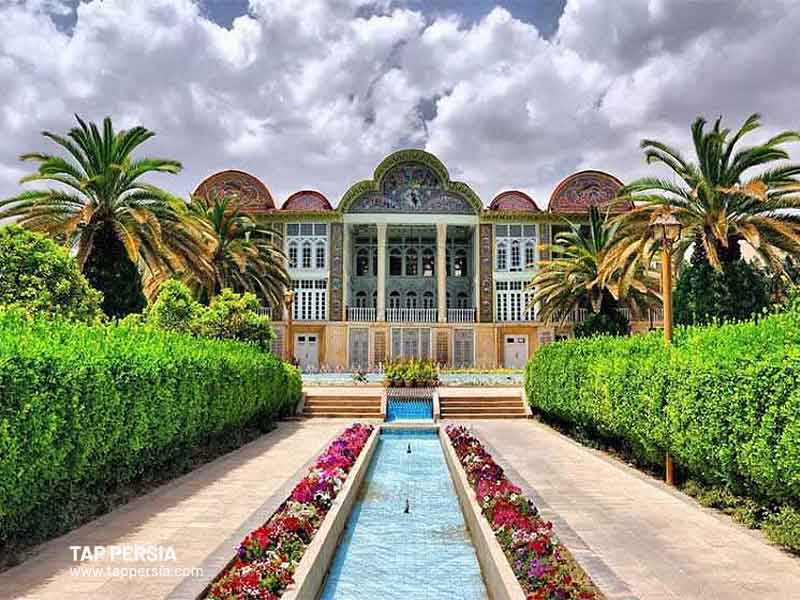
Northwest of Shiraz is where you’ll find Eram Garden, a magnificent historic garden and a great Shiraz historical place. It is a distinctive historical garden that was included on the World Heritage List during the UNESCO World Heritage Committee’s 35th session in 2011. The garden has stunning flower gardens and artistic-historical relics.
Among the other cypress trees on this street, there is a tall one that can be seen from a long distance. This tree is referred to as “Sarv-e Naz” because of its unusual qualities (Elegant Cypress). Historians estimate the age of this cypress to be 1,000 years.
The mansion in the garden was built during the Qajar era, and this particular monument features some of the most fascinating tile work from that time period on the front portion of the central porch and all around it.
While Eram Garden showcases the timeless beauty of Persian gardens, the allure of these gardens is particularly accentuated during the fall season. Delve deeper into this seasonal transformation by exploring the beauty of Persian gardens in the fall, where the vibrant hues of autumn leaves blend harmoniously with the intricate designs of these gardens.
4-Vakil Bazaar
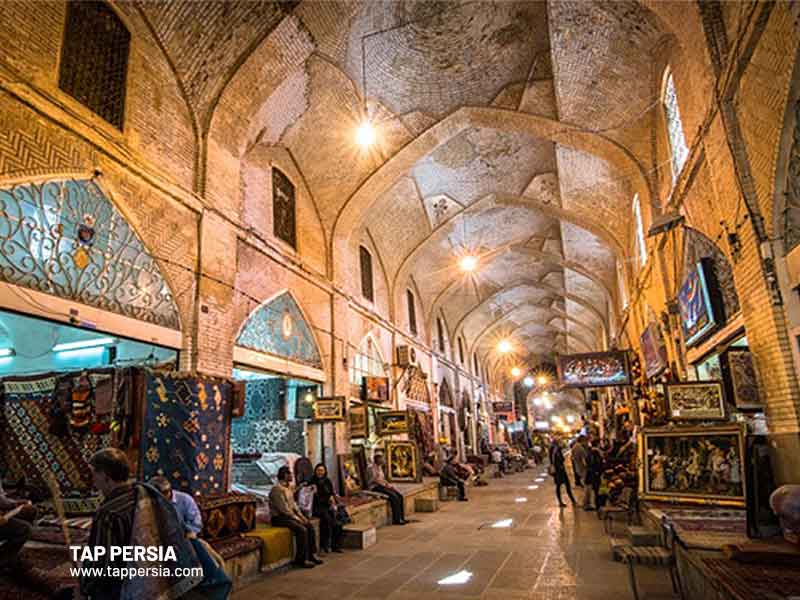
One of Iran’s most well-known traditional and ancient bazaars is the Vakil Bazaar in the city of Shiraz. This market is one of the greatest Shiraz historical places, which Karim Khan Zand (1758-1779) had built, and is presently situated in the heart of Shiraz (east of Shohada Square). In addition to the market, there are additional locations, including the old mosque and the Vakil spa.
Vakil Bazaar is constructed in the shape of a plus sign (+), which means it has wings on the north, south, east, and west. Their crossing features a long, wide four-way with four enormous doors that are locked at night to ensure the bazaar’s security.
The registration number for this artifact is 924, and it was recognized as a national artifact of Iran on July 8th, 1972.
5-Qavam House
Another one of Shiraz’s historical places is the Qavam house. The main structure of this classic Persian garden, which is located on the park’s northern side and contains a fountain in the center, was constructed between 1879 and 1886. A descendant of the Qavam dynasty who was originally from Qazvin, Mirza Ebrahim Khan is credited with constructing the Narenjestan Garden.
The home was typical of those built in the 19th century for families from the upper class. The House in Shiraz served as the Pahlavi University’s Asia Institute’s main office during the second Pahlavi dynasty. Shiraz University and the personnel of the Asian Institute acquired control of Narenjestan in 1965.
This structure was particularly distinctive in Shiraz due to its high-quality architecture, brickwork and tiled frameworks, saw-cut carvings, woodwork, mirrors, glass, plasterwork, paintings, and other ornamentation. Visitors to this mansion get a rare opportunity to view Shiraz’s architectural heritage.
The ceilings of the home are decorated with mirrors and glasswork, while the walls have paintings on them. One of the rooms has a marble fireplace, and on top of it is a picture that shows a scene from the Persian Empire’s heyday.
6-Vakil Mosque
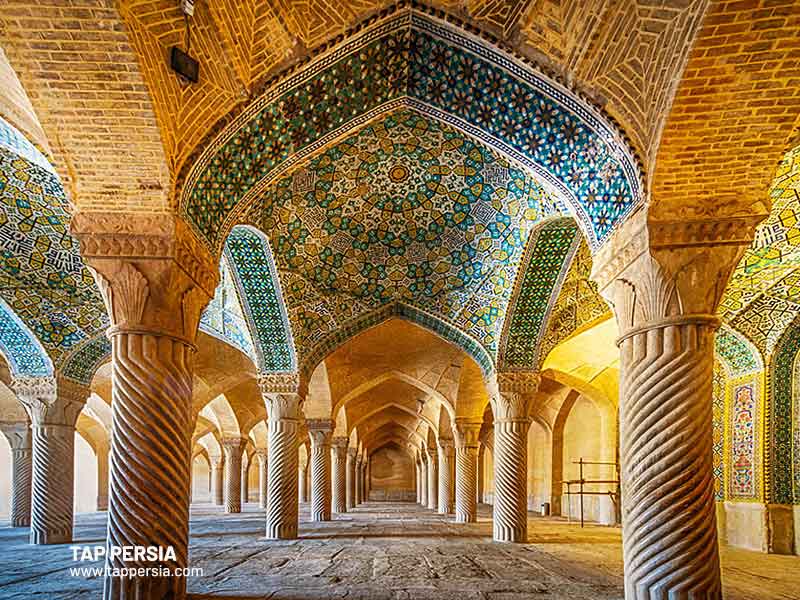
Shiraz’s Vakil Mosque is a mosque that sits just opposite to the entrance of the Vakil Bazaar to the west. This mosque is also one of the finest Shiraz historical places. Despite being constructed between 1751 and 1773, during the Zand era, this mosque underwent restoration in the 19th century, during the Qajar era.
Karim Khan, the creator of the Zand Dynasty, called himself Vakil, which is Arabic for “regent.” Karim Khan’s government was based in Shiraz, and he donated money to a number of structures, including this mosque. 8,660 square meters is the size of the Vakil Mosque. On the northern and southern edges of a sizable open court, it features two iwans instead of the customary four.
Shirazi haft-rangi tiles, a distinctive element of the city’s art and industry in the second half of the 18th century, are used to embellish the iwans and court. Its night prayer hall (Shabestan), which is over 2,700 square meters in size, has 48 monolithic pillars with spiral carvings, each with an acanthus leaf crown. One of the glories of the Zand era, the minbar in this hall is made from a single, solid piece of green marble and has a flight of 14 steps. The Qajar era is chiefly responsible for the flamboyant flowery ornamental tiles.
7-Tomb of Saadi
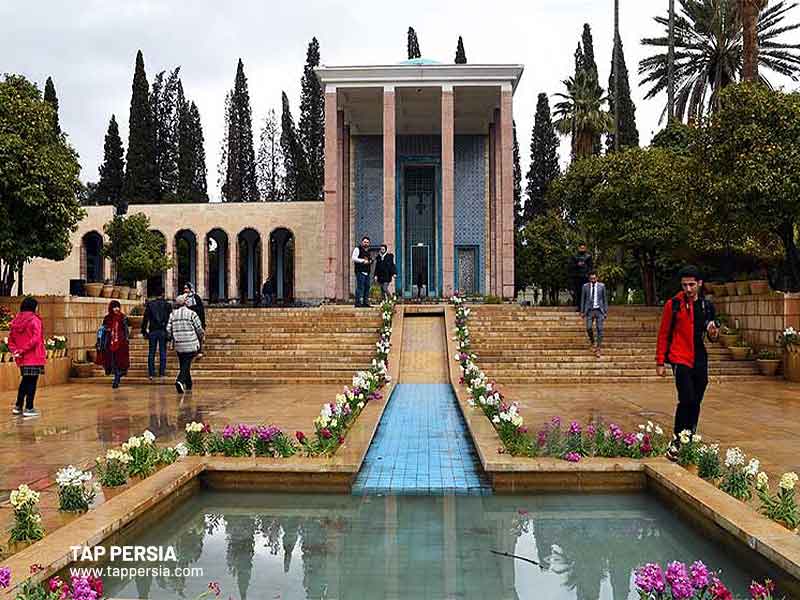
In the Iranian city of Shiraz, there is a monument and mausoleum called The Tomb of Saadi that is dedicated to the poet Saadi. At the current location’s Khanqah, Saadi was laid to rest at the conclusion of his life. A mausoleum for Saadi was constructed in the 13th century by Shams al-Din Juvayni, the vizir of Abaqa Khan.
In the seventeenth century, this tomb was destroyed. A tomb with two levels made of brick and plaster and two chambers on either side was constructed during the reign of Karim Khan. The current structure was constructed between 1950 and 1952 based on a design by Mohsen Foroughi that was influenced by Chehel Sotoun and included both traditional and modern architectural aspects.
A stunning azure blue dome is perched atop the octagonal structure housing the burial, and inside the mausoleum, words from Saadi’s poetry are etched on the walls all around. There is a lovely pond inside the mausoleum yard, just in front of the tomb’s entrance. To make their desires come true, people toss pennies into the pond.
8-Zinat ol Molk House
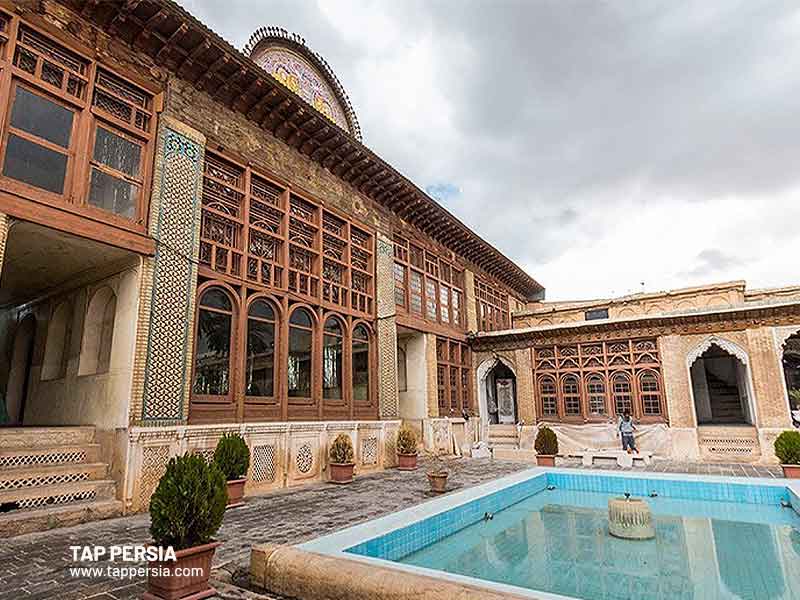
It is said that Zinat Al-Molk House, also known as Zinat Al-Molouk, which is situated on Lotfali Khan Zand Street, is the interior of Gavam House and one of the top Shiraz historical places. It is simple to get to and is close to the Valiasr Metro Station and Bus Terminal.
The complex dates back to the Qajar era when the Qavam dynasty ruled Fars; other Qajar structures from that time include Zinat Al-Molk and Gavam Garden. This location, which lies to the west of Naranjestan, was home to Zinat Al-Molouk Qavami, the daughter of Qavam Al-Molk IV, and was established in 1302 SH.
The entire house has been tastefully designed. After entering the vestibule and the yard, which has two green and lovely gardens on either side, you pass through the entry door with marquetry decorations. You’ll see a square turquoise pool in front of you.
On the other side of the pool, you can see the mansion with wooden windows, multicolored windows, and a stunning arch façade. You arrive at the rooms after passing the porch with decorations.
The Fame Museum of Shiraz has been built in the sizable basement of the mansion which is also known as the Madame Tussauds Museum. Here, sculptures of certain deserving individuals have been aesthetically and expertly crafted, including those of Atossa, Cyrus’s daughter, Shapur I, Karim Khan Zand, Sa’adi, and Dr. Namazi, one of Shiraz’s generous patrons.
9-Vakil Bath
This Zand-era bathhouse’s domed center room has lovely plasterwork and candy-twist columns. After taking a bath in the exquisite heat chamber with a vaulted ceiling, pillars, and a small pool, many dressed-up mannequins show how Shirazis would have unwound by the fountain.
It is situated next to the Vakil Mosque. It has lost its original shape as a result of changes to public bathing facilities. You should schedule a minimum of 15-20 minutes if you plan to visit Vakil Bazaar and this bathhouse (Hammam). In this hammam, which is not a Turkish bathhouse, there are monuments that show you how people used to take showers, conduct business, and engage in other activities. So make sure to check out this bathhouse which is considered one of the most amazing Shiraz historical places.
10-Arg-e Karimkhan
The Arg of Karim Khan, often referred to as the prison of Karim Khan, was established in Shiraz in 1969 at the request of Karim Khan, who founded the Zandieh dynasty. As one of the most spectacular architectural relics from the Zandieh period, this building attracts a lot of tourists each year.
Arg of Karim Khan is located in the center of the city and is widely considered as one of the best Shiraz historical places to visit. When Karim Khan-e Zand decided to make Shiraz the capital of Iran and made this building his home, it became famous with the nickname “Arg of Karim Khan.” The Arg’s four extraordinarily tall exterior walls are 12 meters in height, and they are connected at a 90-degree angle by circular brick towers that are 14 meters in height.
The Arg sustained some damage while it was utilized as a jail during the Pahlavi era of rule. This Arg was given to the then-existing Culture and Art Administration in 1971. The Cultural Heritage Organization of the Islamic Republic of Iran is presently in charge of overseeing this enormous building. The registration for this building was made in 1972, and the registration number is 918.
11-Qur’an Gate
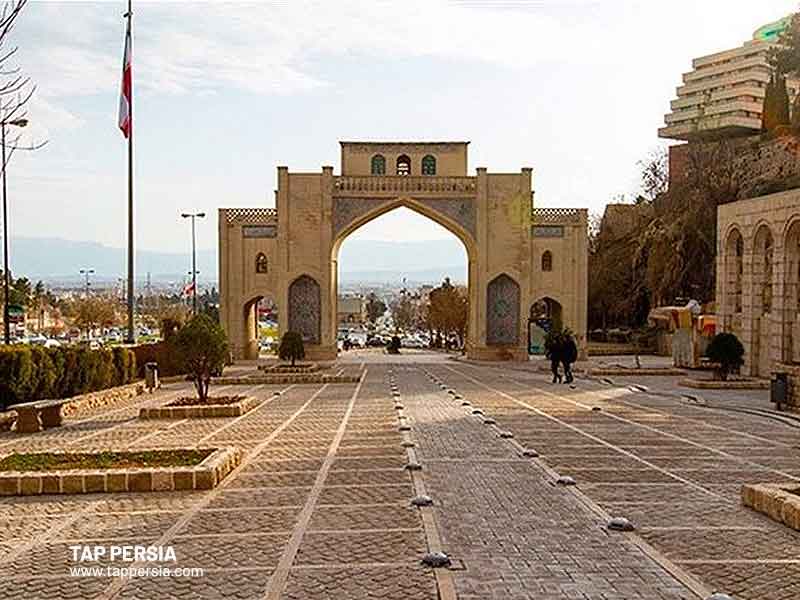
Ad-rule, Adud Dawla’s first time seeing The Gate’s building. It was rebuilt and a small room was built to the top, where Sultan Ibrahim Bin Shahrukh Gurekani kept handwritten copies of the Qur’an because it had sustained substantial damage by the time of the Zand dynasty. The two Qur’ans are referred to as “Hifdah-Man.” It was believed that the Holy Book would bless travelers as they departed Shiraz and passed beneath the gates.
The gate was damaged by many earthquakes throughout the Qajar era, but Mohammad Zaki Khan Nouri ultimately fixed it. The two Qur’ans were taken from the gate in 1937 and put on display at the Pars Museum in Shiraz. In 1949, the arch of the gate was renovated by a businessman by the name of Hosein Igar (also known as E’temad Al-Tojar).
The gates are currently a part of a city park where Shiraz citizens relax and have picnics.
12-Shah-e-Cheragh Shrine
As one of Iran’s most treasured religious locations, the burial of Imam Reza’s brother and the shrine at Shah-e Cheragh are often visited by locals and pilgrims alike. It is widely considered one of the greatest Shiraz historical places. Many international travelers also attend this holy place each year because of the meditative atmosphere and surprisingly seductive beauty of its shining temple.
In contrast to Hafezieh and Sa’dieh, women are not allowed to enter the shrine to pay a visit without chadors. Female tourists are frequently delighted to don those wonderful chadors and feel like a part of the Islamic culture that is prominent in Iran, but there are numerous flower-adorned chadors that may be handed to you.
The mosque’s beautiful design, history, and mirror composition in the walls and ceiling are all covered by a free tour guide. Another unforgettable experience is listening to Muslims praise God while sitting in the courtyard. Streams of water must flow to the pool.
13-Persepolis palace
At the top of the steep peak of Rahmat in the plain of Marvdasht, the remnants of the Takht-e-Jamshid palace are conspicuously situated. The name Parsa, which is 70 miles northeast of Shiraz, is derived from the Greek term perses polis, which means “Persian City,” and alludes to the ancient Iranian city of Parsa. King Darius the Great, who ruled from 522-486 BCE, began work on the site’s construction in 518 BCE, and it took 150 years to finish. “City of The Persians” is what the name Parsa signifies. Takht-e-Jamshid is a recognized World Heritage Site by UNESCO.
The two-ramp staircase that makes up the complex’s entrance is made up of 110 quite wide and short steps. Two statues depicting a bull with a human head and wings mark the main entrance, often referred to as “The Great Gate,” which is situated at the top of the stairways. There are exits for both directions: eastbound and southward. The south exit or gate connects to the Apadana Palace(Perspolis Palace).
Final Words
Shiraz is one of your greatest options if you’re interested in learning about Iran’s historical past. There are several Shiraz historical places both inside and outside of the city that might help you learn more about this region. All previous visitors who have visited Shiraz have been in awe of its beauty and depth of cultural heritage.
So pack your suitcase and head over to this beautiful city to see Shiraz tourist attractions(Iran historical Places) and truly feel historical magnificence and beauty like never seen before!

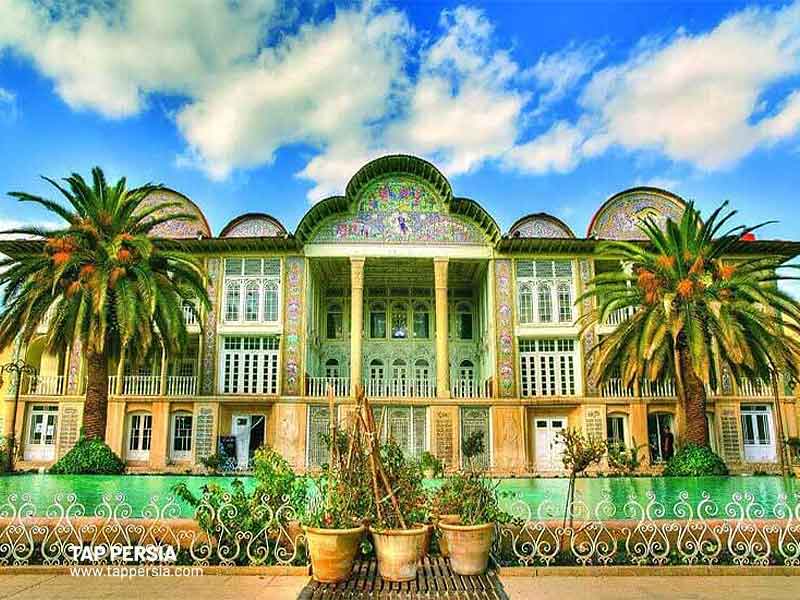


Comment (0)